Southern Yucatan On The Fly
by Richard Post, Telluride Angler
I love to fish the Yucatan, so I’m writing this article to help simplify the gear selection process for other anglers visiting this world class fishery, whether staying at a fly fishing lodge or exploring DIY.
We get inquiries all the time from anglers planning to gear up for someplace tropical. A Google search will produce a litany of “how-to’s,” “gear lists,” “fly selections” and “top 5 do’s and don’ts.” Lodge gear lists tend to list every single item that could possibly be useful, leaving the angler scratching his head about what to actually buy and bring.
The Essentials: Gear for 6 days of fishing
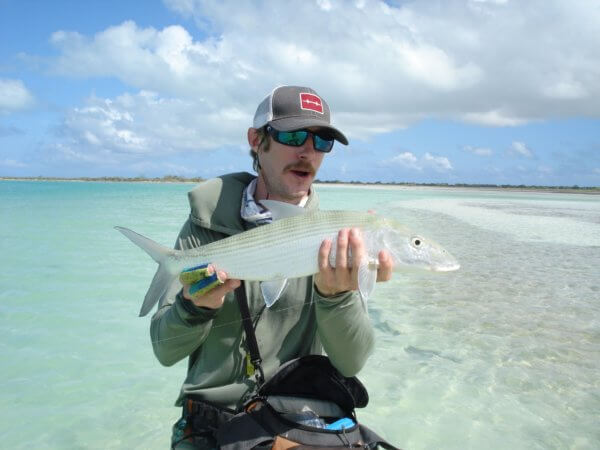
Rods
Bonefish: 7 or 8-weight
Permit: 9 or 10-weight
Tarpon: 10-weight
Just one rod? Make it a 9-weight.
Reels
One to match each rod with floating lines
Suggested: backup 9-weight reel
Leaders
Bonefish: 10 foot 16# tapered leaders (4 leaders)
Permit: 10 foot 20# tapered leaders (4 leaders)
Tarpon: pre-tied leaders with 60lbs shock tippet (3 pack)
Tippet
#12 to #30 1 spool each fluorocarbon
#60 or #80 fluoro for tarpon
Flies
2 dozen bonefish flies #6-#8 following the 3 colors, 3 weights format (more on this below). 1 dozen permit crabs and shrimp (olive, tan, sand colored) that swim a little differently from one another. 1-2 dozen flies for tarpon, snook, baby tarpon, jacks and cuda if you so choose to chase these fish.
Gear Bags and Packs
Waterproof gear bag for the boat. Waterproof lumbar or sling pack for wading.
Footwear
Flats booties, neoprene booties or both
Sunglasses
Two pair, 1 copper or brown lens, 1 yellow lens (low-light)
Clothing
Lightweight, long sleeved and sun proof. Bring a shade hat and rain jacket, too. See notes below for expanded recommendations.
[Read Richard’s Personal DIY LIST]
In-Depth Equipment Recommendations
Rods
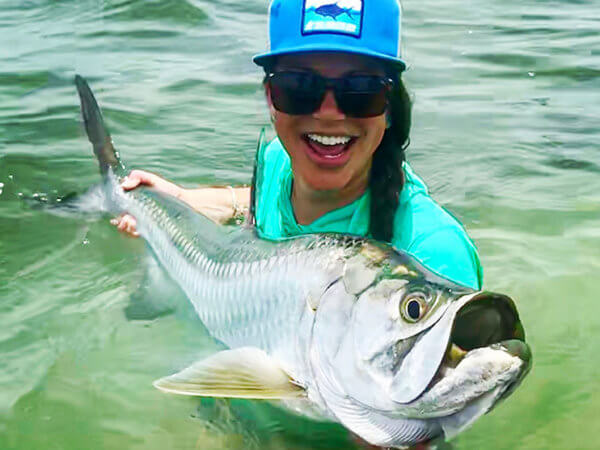
Anyone who has fished for a grand slam knows that one rod won’t quite cut it. Bonefish sticks for this area can be anywhere from a 7 to a 9-weight. Your permit rod is a 9 or 10-weight. Your tarpon rod will be a #10 or #11, although a 10-weight will generally cover the “baby tarpon” up to 50 lbs that are common around the Yucatan. This fishery is renowned for species variety, so ideally, a guided client in a skiff or panga should have a rod rigged for bones, permit and tarpon ready to cast at a moment’s notice. If you only want to bring two rods, carry an 8 and a 10 because a 7 and a 9 may leave you a little under gunned at times.
For the DIY adventurer, pick your target species and have that rod on the ready. If you want to catch a permit, don’t hold the bonefish rod, hold the permit rod. If you’re wading the flats carrying one rod, carry a 9-weight with a shrimp style fly small enough for a bone, but big enough to entice a permit. If you’re carrying two rods South Pacific style, carry an 8 and a 10. Rig the 8 for bones and the 10 for permit. You are unlikely to get a reasonable shot at a tarpon on foot, just being real. A 7 and a 9-weight combo will work as well, but the 10 gives you a little insurance for a doormat permit. The economical angler packing just one rod should choose a 9-weight, light enough for bones, heavy enough for most permit and a great rod to try and break on a big tarpon.
Reels & Backing
There are a lot of reel options out there and the only thing I would say is mandatory is to have a machined reel with a large arbor. Sealed drags are nice, but Tibor fans know this is not mandatory. Remember, any reel can fail if it is neglected. Make sure to rinse your equipment with fresh water after each use. Choose a reel that balances well on the specific fly rod(s) for which it is intended. Don’t be afraid to ask our opinion on rod and reel pairings.
Here are my authentic backing minimums for the grand slam species. Bonefish require at least 150 yards and any backing material is suitable for these fish. Permit need a little more and if you fish an 8 or 9-weight rather than a #10, consider using a touch extra to compensate for less stopping power from the rod. Two hundred yards is adequate for Permit, but 250 to 300 yards is not overkill. Either twenty or thirty pound is fine and 30lb Gel Spun may be used if you want greater length from a material of finer diameter. (Some anglers consider gel spun backing “less friendly” than standard braided Dacron. It is flat under tension and can cut into itself if not spooled tight. It can also cut/burn your fingers if the fish runs on you). Tarpon is where it gets a little more serious. Have at least 250 to 300 yards of 30 lb. You can put more on your reel, but keep in mind that 400 yards of backing and a 100 foot fly line is really close to a quarter mile in linear feet. At some point you’ll want to get your fly line back if that fish gets too far away. Also, tarpon fishing will usually occur in a boat. Boats have motors, which regularly prove useful when playing long-running tarpon. I use bimini loop knots in all my saltwater reels for ease of rigging and a very strong connection.
Reel side note. I never buy extra spools for saltwater trips. If I have an extra spool for a reel, I will bring it with a different line taper, but it is not a backup or intended to be fished on another rod. I prefer to bring extra reels with a backing capacity that will accept a range of lines. For example, with a 7 and a 9 weight setup, I will bring an extra 8 weight reel that could work with the 7 or the 9 if either of those reels blow up. An extra spool in this case just means extra gear you can’t fish.
Lines
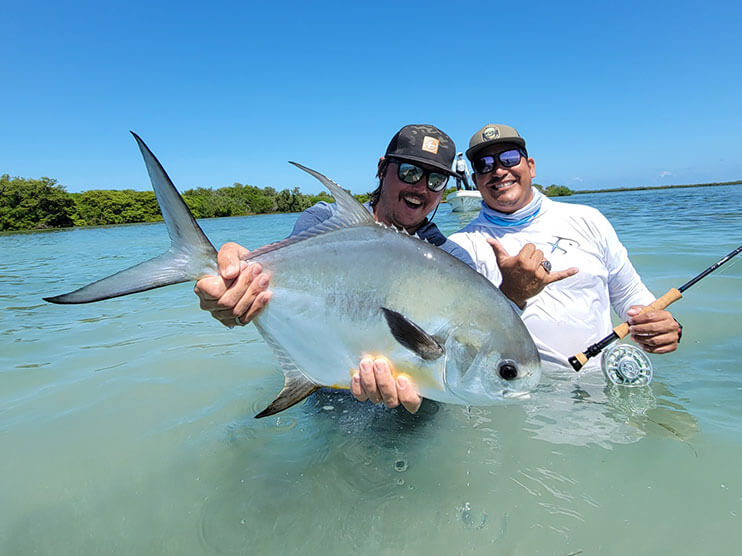
Grab a floating line and go fishing. If you’re new to the game, consider over-lining your rod or choosing a short headed/overweighed fly line. Paired with the correct rod, these shorter, heavier lines really help the inexperienced angler make the necessary 40-50 foot cast. Intermediate lines don’t play a major roll in the Yucatan. They can be instrumental for tarpon fishing, but not permit. Most guides in the Yucatan still prefer floating lines across the board.
As a side note, bring some extra lines with you. I buy new lines for every trip. I practice with last year’s lines in the yard, then I take them for backup. I bring a backup line for each line weight I plan to fish, but rarely are these backup lines new. Please consult our fly shop for specific fly rod/line pairings. Every rod has a favorite line.
Leaders
As a rule, I put brand new leaders on every reel before I go and bring an extra leader per every other day of the trip. For example, on a 6-day fishing trip for bonefish and permit I will put a new leader on the 7 and 9-weight and bring 3 extra leaders for each reel, 8 leaders total for the two reels for 6 days of fishing. I like 10-foot leaders. I tend to fish mono leaders and fluorocarbon tippet. I start with a 10-foot 16# leader for bones with 12# fluoro tippet, and 10-foot 20# leaders for permit with 16# fluoro tippet.
For tarpon, I build my own leaders from my stock of tippet that I bring with me (see tippet section). My tarpon leader is as follows: about 4-6 feet of 60#-80# fluoro for a butt section. Next I add about 2 to 3 feet of 30# (same breaking strength as my backing for line recovery in a pinch) and finally add about 18” of 60#-80# shock tippet. This leader turns over well into the wind and the shock tippet can be nipped off quickly if you need to change target species.
For the bonus species like Jack Crevalle, I fish the same tarpon leader. For barracuda, I replace the shock tippet with knottable wire bite tippet. I tie Albright knots if the tippet difference is severe (30# knotted to 60#, 80# or wire bite tippet) and blood knots for all the rest. If the Albright knot isn’t for you, double blood knots will as well (double up the lighter material and tie a blood knot).
Tippet
I bring fluorocarbon with me. It sinks, it’s stronger, it’s less visible to the fish and it ties a great knot. I bring one spool of each of the following: 80#, 60#, 40# or 50#, 30#, 20#, 16#, 12# and possibly a spool of 10#. I bring a spool of bite tippet for barracudas. With this lineup I can tie a leader for anything that I will encounter. If you’re with a guide, you can omit the heavy stuff (if you bring some pre-tied tarpon leaders) and just take 30# to 12#.
Flies
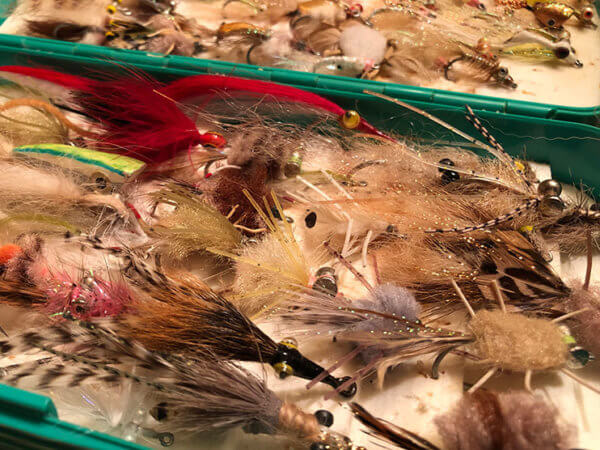
Bonefish. For the Yucatan, keep them small. Not quite Christmas Island small and sparse, but closer than you think. I like sparse flies in the #6 to #8 range. Have three colors and three weights for your patterns. Example, when I tie a Charlie for this area, I tie it in olive, tan and light tan or sand. This simply means, dark, lighter and lightest color. You will choose your color to match the predominant color of the bottom. I will tie the three colors of Charlies with the following weights: dumbbell eye, medium bead chain and no weight or mono eyes. This system gives me three colors, each with three weights to match depth. Wading a 3-4 foot flat, I fish a dumbbell eye. Wading a 2-3 foot flat I fish medium bead chain. Wading a calf to ankle deep flat, I fish no weight or mono eyes. Patterns can be all over the place, but if you stick to the 3 color, 3 weight plan and have a little variety you will be covered. Bonefish tend to be a little one note down here, once you figure out how they want to see the fly, you ought to do pretty well.
Permit. Damn permit. They are some scrupulous diners and will often refuse a perfect presentation with the right fly. Keep playing the game and make your best effort with each fish. Permit mainly eat crabs and shrimp and in the Yucatan they eat the shrimp surprisingly well. Bring a selection of crabs with different looks, mainly in how they swim and sink. Have olive and tan variations that are mostly the size of a nickel. Have a couple large quarter sized ones, too, if you find fish in deep or dirty water. How the fly swims when stripped is important for both shrimp and crab imitations here. You want to have a 3 to 5 count of drop time before it hits the bottom. This gives you time to adjust your strip to the fish before the fly gets in the wheel house. Mantis shrimp imitations and crabs should be in the #6 to #2 range, good luck and good fishing.
Tarpon. You probably don’t need a ton of these, you’re not in the Keys. Good sharp 1/0 to 3/0 hooks are important and standard colors work well. I also use the light and dark selection method for tarpon. For darker bugs go with purple/black and black/red. Fish these early in the morning or when visibility is compromised. In the bright sun I like bright or natural. Classic cockroach colors are good. Have some tans and yellows in these flies and keep them smaller than the darker flies. Mix in some tan, orange, yellow and chartreuse combos as well. My tarpon box has black/purple, black/red, tan/natural, tan/yellow, tan/orange, chartreuse/yellow color combos tied light. Remember that tarpon feed looking up, so your patterns need to ride in the upper couple feet of the water.
Baby tarpon and snook. These fish are great fun and I like to throw gurglers and other surface patterns at them. Bead chain eyes with a muddler style head also make a great fly that rides at the correct depth. I like natural colors with a little bit of pop for these flies. Weed guards are awesome for the mangroves. Keep them smaller than you think, too: #4 to #1/0. Baitfish patterns work well and a selection of Clouser Minnows are always useful. Chartreuse and white is never a bad combination.
Side note: I always have some all-white and some all-black Clousers in my box wherever I fish saltwater.
For the DIY angler on limited time, a dozen bonefish flies following the 3-weight 3-color principle, a few shrimp and crabs for the shot at a permit, and a tarpon fly or two in dark and natural will make you dangerous.
Footwear
This is a very important piece of the puzzle. If you’re planning on mostly wading, get a pair of proper flats booties, our perennial recommendation for which is the Simms Flats Sneaker. Bring a couple pairs of polypro, cotton or light neoprene socks to wear under your bootie. If you go with cheap cotton socks, just deposit them in the trash before you leave the island. I like gravel guards over my boot tops, but they are certainly optional.
Tip: When casting from a skiff or SUP board, fish barefoot so you can feel the line if it gets wedged under a toe or heel. There is nothing worse than coming up 30 feet short on a 40 foot shot.
Sunglasses
This may be the single most important piece of gear on the flats. Flats fishing is sight fishing and if you can’t see them, you will not have a productive time trying to catch them. Bring multiple sunglasses with different lenses, have a backup pair and make sure they’re comfortable to wear all day with a hat. I always, always, always have at least two pairs with me at all times. I carry a copper lens for high contrast and a yellow lens for overcast days, early mornings and evenings. Go with a glass lens that won’t scratch when wiping off salt crystals. Here’s a trick. Buy some alcohol glasses wipes and clean your shades whenever you get a smudge and before each session. For the guided angler, wear your backup shades for the run out to the flats. Salt spray over the gunnels will wreak havoc on clean shades.
Clothing
For the fishing, I wear lightweight long sleeved clothing for the most part. I use less sunscreen and cover up my pale Colorado skin rather than slather it on. You can get away with shorts but remember to put some screen on the backs of the knees. I like sun hoodies to cover my ears and shade my face. The hood also helps to keep the hat in place in the wind. I also keep a sun gaiter in my bag in case I need extra protection for my face. I do the same with sun gloves, although I tend to wear these more than the buff. Wear synthetic underwear to deflect salt, dry quickly and keep the salt chafe in check. Bring a light rain jacket, especially if you’re fishing out of a boat.
For apres flats fishing and happy hour, I like to have some nice lightweight cotton clothing. Light, airy, hemp and linen blends feel so good after shucking salt-soaked synthetics following a freshwater rinse. Keep your long pants close at hand, though. Sand flies, aka No-See-Ums, come out nearly every evening at dusk when the wind lays down.
Don’t Forget These
Some of these things are simple; all of these things are useful.
Sunscreen Stick: I like these for the face and hands because I can put it on without much fuss and I don’t have to rub it in. Less sunscreen on the line, tippet and flies.
Aloe Vera After Burn Gel: this is a product only found where gringos live. If you find it in Mexico or Belize it is expensive, if you can find it at all.
Hook File: sand, salt and coral constantly erode hook sharpness. Check hook points frequently.
Waterproof bag: great on the boat and for all purpose travel. When you’re traveling in small planes, automobiles and boats in tropical climates, your bags are constantly exposed to the elements. Fishpond Thunderhead Submersible Duffel.
Waterproof lumbar pack or sling pack. My favorites are the Fishpond Thunderhead Submersible Lumbar and Fishpond Thunderhead Sling.
Fishpond Dakota Carry Case: Indispensable rod and reel carry all for the traveling angler
Saltwater pliers: The relatively new Simms Flyweight Plier is our go-to for saltwater fishing. Small, light, ergonomic and anodized, the Flyweight Plier has powerful jaws and precision line cutters.
Good Nippers: If your pliers come with line cutters, you can skip these. Otherwise, you’ll need salt-proof nippers of one kind or another. On the third or fourth day of your trip, you’ll find out whether your nippers are salt proof.
Bug Dope or Bugstopper: Make sure you have a plan to fight the bugs. Just like the sun and wind, bugs can make a trip more difficult. I bring the deet.
Richard’s DIY List for One Week in Mexico
This is my actual equipment list that I am taking to Mexico at the end of the month. I am doing this trip in the DIY fashion, and as a result, my list is deeper than if I were staying at a lodge. I plan on fishing off a SUP board and wading. Here’s what’s in my kit.
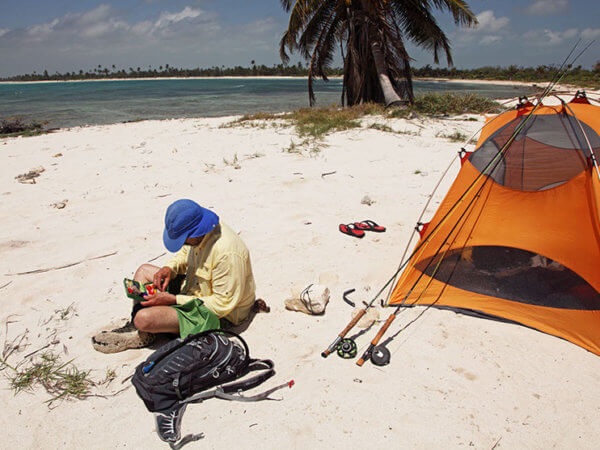
Bonefish- Sage Salt R8 790-4 (primary), Scott Sector 906-4 (awesome on calm days)
Permit- Scott Sector 909-4
Tarpon- Sage Salt R8 1090-4
Reels
6 weight – Abel SDF 5/6 with Rio Redfish WF6F
7 weight – Ross Evo R 7/8 with Rio Elite Bonefish WF7F
9 weight – Nautilus CCF X2 8-10 with Rio Elite Flats Pro WF9F
– Sage Enforcer 9/10 with Rio Elite Permit WF9F
10 weight- Hatch Iconic 9+ with Rio Elite Flats Pro WF10F
Lines: I’ll pack a backup 7 and 10 weight floating line and clear intermediate for the 10 weight
Leaders: 6 bonefish leaders, 6 permit leaders
Tippet: 1 spool each 12#, 16#, 20#, 30#, 60#, 80# Rio Fluoroflex Salt
Footwear: Simms Flats Sneakers with wet wading sock and neoprene gravel guard.
Sunglasses: Costa Blackfin 580G Copper Silver Mirror and 580G Sunrise Silver Mirror
Flies: All of my saltwater flies, way too many for sure.
Clothing: I wear lightweight sun hoodies almost the whole time, some days with shorts, some days in lightweight long pants. On a SUP board or in a kayak I like shorts. All day wading, I like long pants. I will bring a set of bugstopper clothing too. Patagonia Capilene underwear, some board shorts and my Patagonia Swiftcurrent rain jacket will round out my kit. Side note: all of my clothes for the trip fit into a Patagonia Black Hole cube. My clothing is the smallest part of my kit. You don’t need a lot, so I limit myself to the packing cube.
Fishpond Thunderhead Submersible Duffel
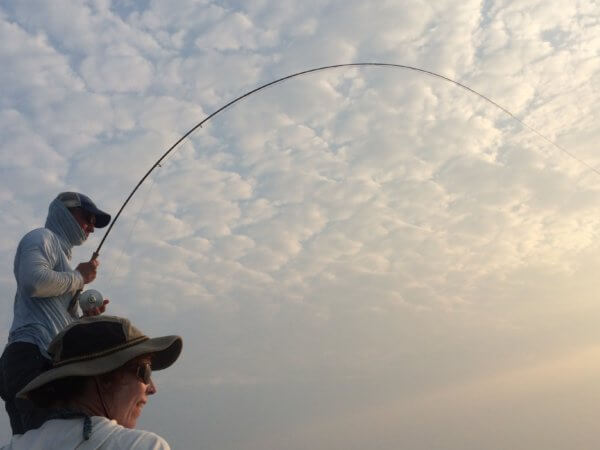 Simms Flyweight Pliers
Simms Flyweight Pliers